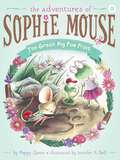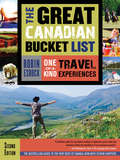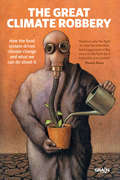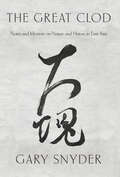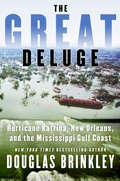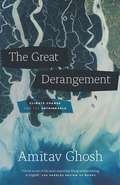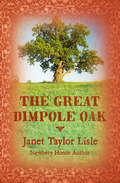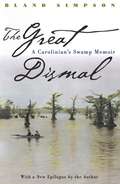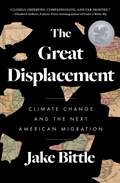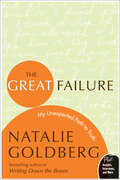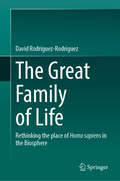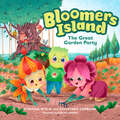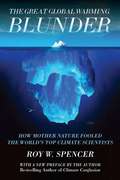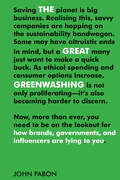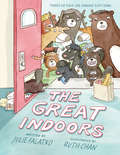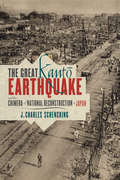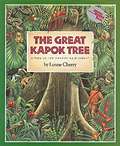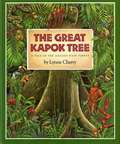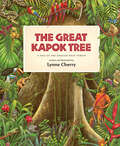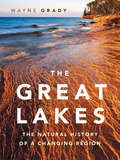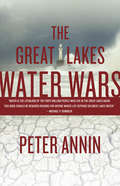- Table View
- List View
The Great Big One
by J. C. GeigerWith natural disasters and nuclear war threatening their small town, two twin brothers find themselves enraptured by mysterious music that could change the course of their lives.Everyone in Clade City knows their days are numbered. The Great Cascadia Earthquake will destroy their hometown and reshape the entire West Coast—if they survive long enough to see it. Nuclear war is increasingly likely. Wildfires. Or another pandemic. To Griff, the daily forecast feels partly cloudy with a chance of apocalyptic horsemen.Griff&’s brother, Leo, and the Lost Coast Preppers claim to be ready. They&’ve got a radio station. Luminous underwater monitors. A sweet bunker, and an unsettling plan for &“disaster-ready rodents.&” But Griff&’s more concerned about what he can do before the end times. He&’d like to play in a band, for one. Hopefully with Charity Simms. Her singing could make the whole world stop.When Griff, Leo, and Charity stumble upon a mysterious late-night broadcast, one song changes everything. It&’s the best band they&’ve ever heard—on a radio signal even the Preppers can&’t trace. They vow to find the music, but aren&’t prepared for where their search will take them. Or for what they&’ll risk, when survival means finding the one thing you cannot live without.
The Great Big Paw Print: The Great Big Paw Print; It's Raining, It's Pouring; The Mouse House; Journey To The Crystal Cave (The Adventures of Sophie Mouse #9)
by Poppy GreenSophie Mouse discovers a giant paw print in Pine Needle Grove—and follows it right into a bear’s den—in the ninth charming book of The Adventures of Sophie Mouse series!While Sophie and her friends are exploring Sassafras Alley, they come across a huge paw print. They have seen paw prints before, but they’ve never seen one this big! What sort of animal could have made such a giant paw print? As the friends go on an adventure to find out, they are in for a great, big surprise! With easy-to-read language and illustrations on almost every page, the Adventures of Sophie Mouse chapter books are perfect for beginning readers.
The Great Canadian Bucket List: One-of-a-Kind Travel Experiences
by Robin EsrockA National Bestseller! Fully revised with new chapters and fascinating destinations to explore, renowned travel writer Robin Esrock guides you to Canada’s most incredible experiences. Having visited more than 100 countries on 7 continents, Robin Esrock has built a career chasing the extraordinary. His bestselling Bucket List books feature experiences that are entirely unique, instantly memorable, wholly inspirational, and available to all. Celebrating his adopted home of Canada, Robin journeys to every province and territory to reveal the remarkable activities and destinations that are unique to the True North strong and free. Get ready to: Cross the mythical Northwest Passage Cycle across Prince Edward Island Float on Canada’s very own Dead Sea Feel the hot breath of a wild polar bear Cave bash along Quebec’s Magdalen Islands Sail among whales in the “Galapagos of the North” Taste Canada’s best poutine, smoked meat, and fish and chips Raft a tidal wave, roll your car uphill, camp in the Arctic and much more! Robin packs each chapter with colourful descriptions, unforgettable characters, quirky trivia, and eye-popping photography. With more than 70 exciting new experiences, the new edition unlocks an extensive online companion where you’ll find videos, galleries, maps, reading guides, and all the practical information you’ll need to follow in Robin’s footsteps.
The Great Climate Robbery: How the Food System Drives Climate Change and What We Can Do About It
by GRAINThe Great Climate Robbery connects analysis of the food system to larger issues affecting the planet, and link peoples’ struggles over food to climate change. This book will help readers to understand the ways in which corporations control the food system and provide the analysis needed to challenge this control.
The Great Clod: Notes and Memoirs on Nature and History in East Asia
by Gary SnyderFor the full course of his remarkable career, Gary Snyder has continued his study of Eastern culture and philosophies. From the Ainu to the Mongols, from Hokkaido to Kyoto, from the landscapes of China to the backcountry of contemporary Japan, from the temples of Daitokoji to the Yellow River Valley, it is now clear how this work has influenced his poetry, his stance as an environmental and political activist, and his long practice of Zen. Growing up in the Pacific Northwest, Asia became a vocation for Snyder. While most American writers looked to the capitals of Europe for their inspiration, Sndyer looked East. American letters is profoundly indebted to this geographical choice.Long rumored to exist, The Great Clod collects more than a dozen chapters, several published in The Coevolution Quarterly almost forty years ago when Snyder briefly described this work as "The China Book," and several others, the majority, never before published in any form. "Summer in Hokkaido," "Wild in China," "Ink and Charcoal, " "Stories to Save the World," "Walking the Great Ridge," these essays turn from being memoirs of travel to prolonged considerations of art, culture, natural history and religion. Filled with Snyder's remarkable insights and briskly beautiful descriptions, this collection adds enormously to the major corpus of his work, certain to delight and instruct his readers now and forever.
The Great Deluge: Hurricane Katrina, New Orleans, and the Mississippi Gulf Coast
by Douglas BrinkleyIn the span of five violent hours on August 29, 2005, Hurricane Katrina destroyed major Gulf Coast cities and flattened 150 miles of coastline. But it was only the first stage of a shocking triple tragedy. On the heels of one of the three strongest hurricanes ever to make landfall in the United States came the storm-surge flooding, which submerged a half-million homes--followed by the human tragedy of government mismanagement, which proved as cruel as the natural disaster itself. In The Great Deluge, bestselling author Douglas Brinkley finds the true heroes of this unparalleled catastrophe, and lets the survivors tell their own stories, masterly allowing them to record the nightmare that was Katrina.
The Great Derangement: Climate Change and the Unthinkable (Berlin Family Lectures)
by Amitav GhoshAre we deranged? The acclaimed Indian novelist Amitav Ghosh argues that future generations may well think so. How else to explain our imaginative failure in the face of global warming? In his first major book of nonfiction since In an Antique Land, Ghosh examines our inability--at the level of literature, history, and politics--to grasp the scale and violence of climate change. The extreme nature of today's climate events, Ghosh asserts, make them peculiarly resistant to contemporary modes of thinking and imagining. This is particularly true of serious literary fiction: hundred-year storms and freakish tornadoes simply feel too improbable for the novel; they are automatically consigned to other genres. In the writing of history, too, the climate crisis has sometimes led to gross simplifications; Ghosh shows that the history of the carbon economy is a tangled global story with many contradictory and counterintuitive elements. Ghosh ends by suggesting that politics, much like literature, has become a matter of personal moral reckoning rather than an arena of collective action. But to limit fiction and politics to individual moral adventure comes at a great cost. The climate crisis asks us to imagine other forms of human existence--a task to which fiction, Ghosh argues, is the best suited of all cultural forms. His book serves as a great writer's summons to confront the most urgent task of our time.
The Great Dimpole Oak
by Janet Taylor LisleAn ancient oak tree has seen glory and tragedy—but nothing quite as spectacular as the showdown that&’s brewing For nearly a thousand years, the Dimpole Oak has towered over this small East Coast town, witnessing the passage of history: duels and revolution, lovers&’ trysts and traitors&’ hangings, victory parades and midnight conspiracies. The farmer who owns the land beneath the tree likes to tell stories of the murders and witch trials that took place in its shade. Local children play on the oak&’s great roots and dig for buried treasure. The townsfolk plan a Dimpole Oak Day to celebrate their landmark. Meanwhile, far away in India, a swami has a holy vision of the oak, and begins a journey to find it. Back in Dimpole, two boys take inspiration from the blackguards and pirates of the old farmer&’s tales, and challenge a local bully to a confrontation under the oak. As all these plots and plans converge, the mighty oak stands ready to witness another grand event. This ebook features a personal history by Janet Taylor Lisle including rare images and never-before-seen documents from the author&’s own collection.
The Great Dimpole Oak
by Janet Taylor LisleAn ancient oak tree has seen glory and tragedy—but nothing quite as spectacular as the showdown that&’s brewing For nearly a thousand years, the Dimpole Oak has towered over this small East Coast town, witnessing the passage of history: duels and revolution, lovers&’ trysts and traitors&’ hangings, victory parades and midnight conspiracies. The farmer who owns the land beneath the tree likes to tell stories of the murders and witch trials that took place in its shade. Local children play on the oak&’s great roots and dig for buried treasure. The townsfolk plan a Dimpole Oak Day to celebrate their landmark. Meanwhile, far away in India, a swami has a holy vision of the oak, and begins a journey to find it. Back in Dimpole, two boys take inspiration from the blackguards and pirates of the old farmer&’s tales, and challenge a local bully to a confrontation under the oak. As all these plots and plans converge, the mighty oak stands ready to witness another grand event. This ebook features a personal history by Janet Taylor Lisle including rare images and never-before-seen documents from the author&’s own collection.
The Great Dismal
by Bland SimpsonJust below the Tidewater area of Virginia, straddling the North Carolina-Virginia line, lies the Great Dismal Swamp, one of America's most mysterious wilderness areas. The swamp has long drawn adventurers, runaways, and romantics, and while many have tried to conquer it, none has succeeded. In this engaging memoir, Bland Simpson, who grew up near the swamp in North Carolina, blends personal experience, travel narrative, oral history, and natural history to create an intriguing portrait of the Great Dismal Swamp and its people. For this edition, he has added an epilogue discussing developments in the region since 1990.
The Great Displacement: Climate Change and the Next American Migration
by Jake BittleShortlisted for the 2024 Carnegie Medal for Excellence &“The Great Displacement is closely observed, compassionate, and far-sighted.&” —Elizabeth Kolbert, Pulitzer Prize–winning author of Under a White Sky The untold story of climate migration in the United States—the personal stories of those experiencing displacement, the portraits of communities being torn apart by disaster, and the implications for all of us as we confront a changing future.Even as climate change dominates the headlines, many of us still think about it in the future tense—we imagine that as global warming gets worse over the coming decades, millions of people will scatter around the world fleeing famine and rising seas. What we often don&’t realize is that the consequences of climate change are already visible, right here in the United States. In communities across the country, climate disasters are pushing thousands of people away from their homes.A human-centered narrative with national scope, The Great Displacement is &“a vivid tour of the new human geography just coming into view&” (David Wallace-Wells, New York Times bestselling author of The Uninhabitable Earth). From half-drowned Louisiana to fire-scorched California, from the dried-up cotton fields of Arizona to the soaked watersheds of inland North Carolina, people are moving. In the last few decades, the federal government has moved tens of thousands of families away from flood zones, and tens of thousands more have moved of their own accord in the aftermath of natural disasters. Insurance and mortgage markets are already shifting to reflect mounting climate risk, pricing people out of risky areas. Over the next fifty years, millions of Americans will be caught up in this churn of displacement, forced inland and northward in what will be the largest migration in our country&’s history. The Great Displacement compassionately tells the stories of those who are already experiencing life on the move, while detailing just how radically climate change will transform our lives—erasing historic towns and villages, pushing people toward new areas, and reshaping the geography of the United States.
The Great Eagles: Their Evolution, Ecology and Conservation
by Michael O'Neal CampbellThis book examines the current literature and knowledge on the evolution and ecology of all the birds named as eagles, with particular emphasis on the larger species. It also examines the past and current relations between eagles and people, including habitat change and conservation issues. Eagle ecologies and conservation are currently seriously impacted by human activities such as industrialization, urbanization, pollution, deforestation and hunting. Some eagle species have consequently experienced extreme population changes. There are, however, some positive developments. Eagles have a strong, historic bond with human civilization, due to their status as the world’s most charismatic birds. Conservation policies have also been successful in repopulating some ecosystems with breeding eagles. Therefore, despite the complexity of this relationship, there may yet be hope for this unique species group, frequently rated as the kings of birds, and symbolic of human power, ambition, royalty, nationality, and even concepts of God. It is hoped that this book will contribute to the further understanding of these unique and fantastic birds.
The Great Failure: My Unexpected Path to Truth
by Natalie GoldbergOne of America's favorite teachers, Natalie Goldberg has inspired millions to write as a way to develop an intimate relationship with their minds and a greater understanding of the world in which they live. Now, through this honest and wry exploration of her own life, Goldberg puts her teachings to work.
The Great Family of Life: Rethinking the place of Homo sapiens in the Biosphere
by David Rodríguez-RodríguezThis book explains the causes, consequences and desirable solutions to the unbalanced and unfair relationship between Homo sapiens and the other species that inhabit Planet Earth in a succinct, enjoyable and thought-provoking way. Major sociological, economic, political, educational, religious and phylosophical perspectives are reviewed in order to understand why we have reached the current alarming status of global biodiversity during the Anthropocene, and how we can react to it to attain not just human welfare, but global happiness. The target audience is wide, from the general public interested in the deep inner causes of environmental degradation, to college and university students and lecturers, notably in the fields of environmental ethics, environmental philosophy, environmental law and environmental politics.
The Great Garden Party (Bloomers Island)
by Courtney Carbone Cynthia WylieThe popular Bloomers Island! gardening kits and online world blossom in a playful, beautifully illustrated new book aimed at getting kids to love everything about nature.Join the Bloomers on a whimsical adventure as they attend a magical boarding school on Bloomers Island. As Pete Moss, Rosey Posey, Big Red, Violet, and their friends prepare for the Great Garden Party, they learn about gardening, healthy eating, and caring for the environment. The treehouse school is held by the arms of Mr. Banyan, a tree about to celebrate his 200th birthday. His birthday party is filled with fun games that teach the curious students that gardening is not at all boring or hard—that it’s actually really fun!
The Great Global Warming Blunder
by Roy W SpencerThe Great Global Warming Blunder unveils new evidence from major scientific findings that explode the conventional wisdom on climate change and reshape the global warming debate as we know it. Roy W. Spencer, a former senior NASA climatologist, reveals how climate researchers have mistaken cause and effect when analyzing cloud behavior and have been duped by Mother Nature into believing the Earth's climate system is far more sensitive to human activities and carbon dioxide than it really is.In fact, Spencer presents astonishing new evidence that recent warming is not the fault of humans, but the result of chaotic, internal natural cycles that have been causing periods of warming and cooling for millennia. More carbon dioxide in the atmosphere is not necessarily to be feared; The Great Global Warming Blunder explains that burning of fossil fuels may actually be beneficial for life on Earth.As group-think behavior and misguided global warming policy proposals threaten the lives of millions of the world's poorest, most vulnerable citizens, The Great Global Warming Blunder is a scintillating exposé and much-needed call for debate.
The Great Greenwashing: How Brands, Governments, and Influencers Are Lying to You
by John PabonSaving the planet is big business. Realising this, savvy companies are hopping on the sustainability bandwagon. Some may have altruistic ends in mind, but most want to make a quick buck. As ethical spending and consumer options increase, greenwashing is not only proliferating—it’s becoming harder to discern. But how is someone at the supermarket supposed to decipher all this? In The Great Greenwashing, John Pabon pulls no punches in arming consumers and business professionals with the tools they need to educate themselves, filter out the nonsense from the truth, and make a positive impact.
The Great Indoors
by Julie FalatkoWhen the humans head out to go camping, the animals settle in for a relaxing holiday of their own! Teen bear takes over the bathroom with her curling iron, the beavers prepare their fanciest recipes, and the deer kick up their feet for a dance party. What starts as a little unwinding soon escalates to a big mess, just in time for everyone to head home. . . .Julie Falatko and Ruth Chan's quirky humors shine in this hilarious take on family trips that will have kids wondering what exactly goes on back at home when they're on vacation.
The Great Kantō Earthquake and the Chimera of National Reconstruction in Japan (Contemporary Asia in the World)
by J. Charles SchenckingIn September 1923, a magnitude 7.9 earthquake devastated eastern Japan, killing more than 120,000 people and leaving two million homeless. Using a rich array of source material, J. Charles Schencking tells for the first time the graphic tale of Tokyo's destruction and rebirth. In emotive prose, he documents how the citizens of Tokyo experienced this unprecedented calamity and explores the ways in which it rattled people's deep-seated anxieties about modernity. While explaining how and why the disaster compelled people to reflect on Japanese society, he also examines how reconstruction encouraged the capital's inhabitants to entertain new types of urbanism as they rebuilt their world.Some residents hoped that a grandiose metropolis, reflecting new values, would rise from the ashes of disaster-ravaged Tokyo. Many, however, desired a quick return of the city they once called home. Opportunistic elites advocated innovative state infrastructure to better manage the daily lives of Tokyo residents. Others focused on rejuvenating society—morally, economically, and spiritually—to combat the perceived degeneration of Japan. Schencking explores the inspiration behind these dreams and the extent to which they were realized. He investigates why Japanese citizens from all walks of life responded to overtures for renewal with varying degrees of acceptance, ambivalence, and resistance. His research not only sheds light on Japan's experience with and interpretation of the earthquake but challenges widespread assumptions that disasters unite stricken societies, creating a "blank slate" for radical transformation. National reconstruction in the wake of the Great Kanto Earthquake, Schencking demonstrates, proved to be illusive.
The Great Kapok Tree: A Tale Of The Amazon Rain Forest (Into Reading, Trade Book #9)
by Lynne CherryNIMAC-sourced textbook <p><p> The author and artist Lynne Cherry journeyed deep into the rain forests of Brazil to write and illustrate her gorgeous picture book The Great Kapok Tree: A Tale of the Amazon Rain Forest (1990). One day, a man exhausts himself trying to chop down a giant kapok tree. While he sleeps, the forest’s residents, including a child from the Yanomamo tribe, whisper in his ear about the importance of trees and how "all living things depend on one another" . . . and it works. Cherry’s lovingly rendered colored pencil and watercolor drawings of all the "wondrous and rare animals" evoke the lush rain forests, as well as stunning world maps bordered by tree porcupines, emerald tree boas, and dozens more fascinating creatures.
The Great Kapok Tree: A Tale Of The Amazon Rain Forest (Literature Units Ser.literature Units)
by Lynne CherryNIMAC-sourced textbook
The Great Kapok Tree: A Tale of the Amazon Rain Forest
by Lynne CherryExhausted from his labors, a man chopping down a great kapok tree in the Brazilian rain forest puts down his ax, and, as he sleeps, the animals who live in the tree plead with him not to destroy their world. "This modern fable with its urgent message contains an abundance of information. "--The Horn Book
The Great Kapok Tree: A Tale of the Amazon Rain Forest (Literature Units Ser.literature Units)
by Lynne CherryA modern fable with an urgent message for young environmentalists. "Spectacular." (School Library Journal)Lynne Cherry journeyed deep into the rain forests of Brazil to write and illustrate this gorgeous picture book about a man who exhausts himself trying to chop down a giant kapok tree. While he sleeps, the forest’s residents, including a child from the Yanomamo tribe, whisper in his ear about the importance of trees and how "all living things depend on one another" . . . and it works.Cherry’s lovingly rendered colored pencil and watercolor drawings of all the "wondrous and rare animals" evoke the lush rain forests. Features stunning world maps bordered by detailed illustrations of fascinating rainforest creatures.An IRA Teacher’s Choice * ABA Pick of the Lists * Reading Rainbow Review Book * NSTA-CBC Outstanding Trade Book for Children
The Great Lakes
by Wayne Grady Emily DamstraThe Great Lakes have been central to the development of eastern North America. In this "beautifully designed, comprehensive gem of a guide to the ecosystem at the heart of Canada" (The Tyee), award-winning science and nature writer Wayne Grady makes scientific concepts accessible as he reveals how human impact has changed this life-giving region.The Great Lakes: A Natural History of a Changing Region is the most authoritative, complete and accessible book to date about the biology and ecology of this vital, ever-changing terrain. Written by one of Canada's best-known science and nature writers, it is intended not only for those who live in the Great Lakes region, but for anyone captivated by the splendor of the natural world and sensitive to the challenges of its preservation. It is both a first-hand tribute and an essential guide to a fascinating ecosystem in eternal flux.
The Great Lakes Water Wars
by Peter AnninThe Great Lakes are the largest collection of fresh surface water on earth, and more than 40 million Americans and Canadians live in their basin. Will we divert water from the Great Lakes, causing them to end up like Central Asia's Aral Sea, which has lost 90 percent of its surface area and 75 percent of its volume since 1960? Or will we come to see that unregulated water withdrawals are ultimately catastrophic? Peter Annin writes a fast-paced account of the people and stories behind these upcoming battles. Destined to be the definitive story for the general public as well as policymakers, The Great Lakes Water Wars is a balanced, comprehensive look behind the scenes at the conflicts and compromises that are the past-and future-of this unique resource.

